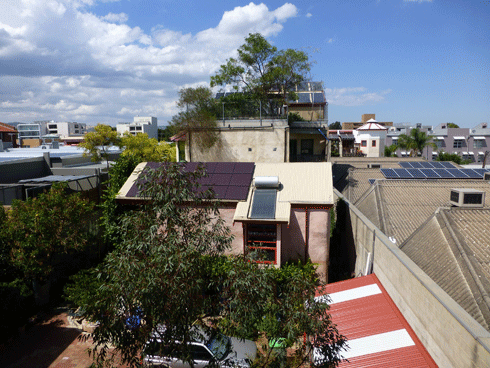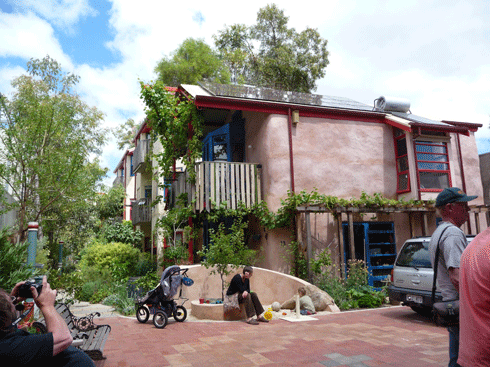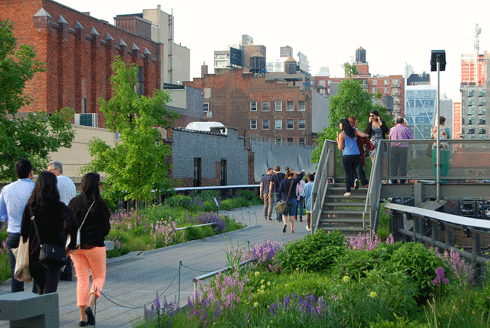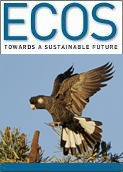
|
Published: 12 June 2013
Grey areas in greening cities
How can we accommodate the extra 6 or 7 million people expected to populate our major cities by 2056 – while also reducing the carbon footprint of individual Australians? Is the answer to increase urban density? But is medium-to-high density development the best way to reduce greenhouse gas emissions from cities? And how can we protect biodiversity in a concrete jungle?

|
|
View of the roof garden at Christie Walk in Adelaide, an eco-village developed on a ‘brownfield’ site. Credit:
Paul Downton
|
In a recent online article, RMIT researchers Chris Ives and Cecily Maller called for an end to the decades-long debate about urban sprawl versus urban densification, arguing that proponents of both sides have created a ‘false dichotomy’ that ‘hinders our ability to make decisions for creating sustainable, healthy and equitable cities of the future’.
‘A new discussion based on desired end states for sustainability must be started,’ they wrote. ‘Rather than a one-size-fits-all solution, special attention should be given to the spatial and unique requirements of the people, species and ecosystems that comprise cities.’
‘Increasing density alone does not guarantee improved energy efficiency. The design of suburbs, efficiency of building stocks, use of appliances and technologies, and how the daily lives of citizens are organised also play a significant role.’
Yet federal and state governments continue to endorse medium-high density housing developments as the ‘one-size-fits-all’ solution to stem urban sprawl and to create more sustainable cities.
One often-cited advantage of higher density, inner urban housing is that residents are more likely to be close to public transport, and distances to and from services are relatively small. This can result in a reduction in greenhouse gas emissions, as vehicle use becomes less frequent.1
But other evidence suggests that high-density, high-rise living is no more sustainable than single-family, detached homes. In 2005 NSW Energy Australia reported that high-rise apartments used 30 per cent more power than a detached home – primarily due to lighting of common areas, including car parking and foyers.
According to Dr Andrew Beer, Director of the Centre for Housing, Urban and Regional Planning at Adelaide University, ‘low rise’ apartments – up to four storeys – have the lowest carbon footprint of any housing form. ‘Much of that saving comes in reduced transport emissions, but also heating and cooling,’ he says.
Another low-footprint approach to new urban forms is the redevelopment of ‘brownfield’ sites – converting existing buildings. In Melbourne, the Westwyck eco-village is being developed from buildings and grounds previously occupied by a primary school in the inner ring suburb of Brunswick West.

|
|
Christie Walk straw bale house and communal children’s sandpit. Credit:
Paul Downton
|
In Adelaide, the Christie Walk eco-village has also been built on a brownfield city site. Initially, 14 dwellings were constructed on an irregular 2000 square-metre site, which is equivalent to around four average house blocks in an outer urban ‘greenfields’ state.
Christie Walk began its life as a community, when prospective residents got together in the planning stages to discuss design and construction. Eventually they formed their own building company to keep dwelling prices affordable in this inner city location.
Architect Paul Downton from Ecopolis, a key player in the project, sees the sense of community and increased social interaction as a plus for this kind of higher-density urban development.
‘The idea of a shared adventure was very much part of the story of Christie Walk,’ he says. ‘The system is stacked against the small player – a successful movement for crowdsourcing architecture would have to be a positive thing.’
Crowdsourcing groups of prospective residents to finance shared housing projects is an idea that’s gaining traction. CITINICHE is an initiative and website set up to bring together individuals with similar ‘living visions’ (or niches). The site is monitored by designers and developers who can put up posts about residential projects that may be of interest to the ‘crowd’.
‘CITINICHE offers bespoke design in what becomes a predominantly self-funded exercise,’ says the enterprise’s managing director, Ivan Rijavec.
‘Those prioritising sustainability can request grey water conservation and usage, the use of low-embodied-energy materials, solar energy generation and roof gardens, for example – options well beyond the minimum requirements of planning and building authorities.’
While the environmental benefits, in terms of energy use and emissions, of more efficient forms of urban housing are becoming clearer, the impacts of housing density on biodiversity have received much less attention.
Recently, however, a team at the University of Queensland modelled the difference in bird biodiversity under two urban development scenarios in Brisbane – a traditional low-density housing development, and a compact medium-high density development, each providing a projected 84 642 dwellings.
The study found a higher diversity of birds in the medium-high density housing, primarily because it kept large areas of parkland and green spaces intact. Low-density urban sprawl resulted in loss of some species, and an increase in pests.
‘Although the local impact on Nature can be very high under high-density housing, the area of impact is [relatively less] than in a low-density sprawling development,’ said Dr Richard Fuller from the University of Queensland, who was involved in the bird study.
‘Higher-density compact developments with interspersed green spaces mean that urban-sensitive wildlife such as many birds, and hole-nesting mammals can persist in larger urban parks. We should be building only on brownfield sites and not clearing vegetation for development.’
More radical ways to support urban biodiversity in an increasingly built-up concrete landscape include biological architecture, such as the Bosco Verticale that will open in the Milan CBD later this year. The two residential towers will host 900 trees and a wide range of shrubs and floral plants. On flat land, each Bosco Verticale is equivalent to 10 000 square metres of forest.
The Bosco Verticale is aesthetically impressive, but it remains to be seen whether Milan’s urban wildlife will utilise the vertical forest. Fuller is skeptical: ‘There is limited evidence that they will benefit wildlife – they shouldn't be used as substitutes for “real” green spaces.’
Paul Downton agrees. ‘For me, it’s about living things, not dead metal and glass. When we understand the way we build is an extension of who we are as a species and that our lives depend on it, then we'll be getting to grips with “sustainability” in a way that really means something.’
1 For example, a study by the Urban Land Institute in the USA found that residents of pedestrian-friendly, high-density communities drive one-third fewer miles than those in conventional suburbs, while in Canada, researchers found that per capita transportation-related emissions were 3.7 times higher in a low-density development compared to high density.




